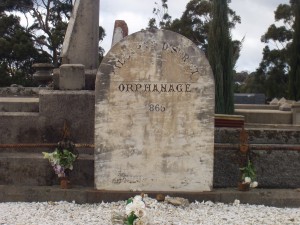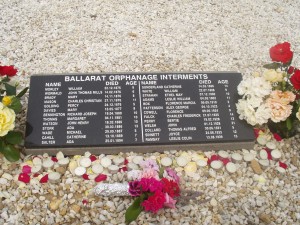The question I am interested in is: Who owns the past?
This page will favour a history-from-below perspective. More on that issue shortly.
♣♣♣
Australian Orphanage Museum
As you read this, I am working with CLAN and others to establish this very important development. To be located in Geelong, but it will be accessible in virtual form and later on in travelling exhibitions. Watch for the new website, but in the meantime, you can follow progress here.
♣♣♣
Ballarat Orphanage History
Until recently, the only history of this orphanage was a centenary history – A Century of Child Care: The Story of the Ballarat Orphanage 1865-1965 – written by Ethel Morris in 1965 at the request of the Board of Management. It is somewhat limited, drawing on Annual Reports which in themselves were superficial. Available in some libraries.
I published a memoir – An Orphan’s Escape: Memories of a Lost Childhood (Melbourne: Lothian 2005) which is an account of my experiences in the Orphanage from 1943-1953.

You can find a short but accurate summary of the Orphanage history on the Find & Connect website.


An even better history exists now. In 2020, Dr David McGuinness completed a PhD thesis recounting a detailed history from the earliest days of the Orphan’s Asylum through to the various phases until the CAFS era. David continues to be involved in the Orphanage heritage and, subject to demands on his time, may be able to answer questions or provide information together with his colleague Dr Ember Parkin. Try calling on
- phone 03 5337 3333 or
- email ember@ashtreeprojects.com.au
From Ember and David
DID YOU KNOW?
Individual files of former residents are stored off-site in a secure, climate-controlled storage facility in Geelong. These have all been digitised and when clients request their records, the digital files are accessed from a secure hard drive.
Due to changes in record keeping practices over the years, there are sometimes significant differences in terms of the content of some client files – some are full to the brim, whilst others are scant on details.
Cafs also has a history collection that contains a range of records including:
· Regular superintendent reports on happenings in the home, including on individual residents’ health, achievements, behaviour and activities. (This is now searchable by name, so if you’d like to find out if the Superintendent was talking about you, please get in touch).
· Photographs – many of which have been digitised and are often brought along to reunions. You know better than we do what the photographs are of, so please get in touch if you would like to help us work out who and what these photos are of.
· Admissions application forms.
· Admissions registers.
· Menu books.
· Important bits and pieces like trophies, show prize ribbons.
· Apprentice accounts, showing who was working where, and for how much.
· Individual education and achievement certificates.
These are all YOUR records. Please feel free to get in touch to talk further, and get your hands on them.
♣♣♣
Heritage Ballarat Orphanage
150th Anniversary – AMBASSADOR to CAFS
I was invited to be an Honorary Ambassador for 2015 – a year that marks the 150th anniversary of the institution known variously as the
- Ballarat Orphan Asylum (from 1865)
- Ballarat Orphanage (1909)
- Ballarat Children’s Home (1968)
- Ballarat Children’s Homes & Family Sevices (1984)
- Ballarat Child and Family Services (CAFS) (1999 to the present)
On 20 February 2015 the Ballarat City Council hosted a Civic Reception to mark the opening of what will be a busy round of events to celebrate the milestone.
Of course, some would not use the verb celebrate because their experiences in the institution were far from cause to celebrate.
On 23 February 2015, the Ballarat Base Hospital “re-gifted” to CAFS a set of 7 paintings that once hung on the walls of the Toddlers Block of the Orphanage. Many of us have fond memories of these quirky paintings that helped enliven what was often a depressing day at the Orphanage. Deb Findlay and I were given the honour of unveiling the paintings.
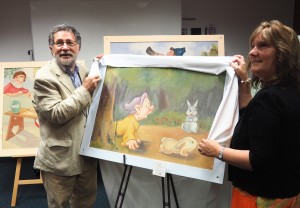
Here’s a sample. They are all on display at Ballarat CAFS.
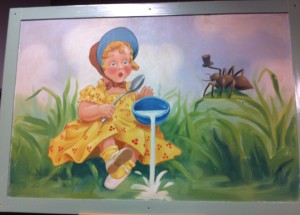
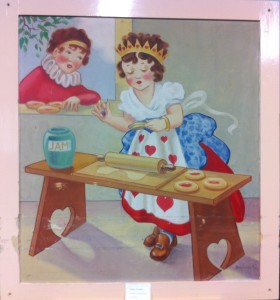

Other events in 2015 included
- Past residents reunion & dinner, 27-29 March
- Opening of the World War 1 Avenue of Honour and replanting of 105 trees to commemorate the service of old boys of the Orphanage, 3 August
- Opening of a Heritage Centre at CAFS, 8 December.
♣♣♣
CHILDREN’S BODIES BURIED AT THE OLD BALLARAT ORPHANAGE? (17 April 2015)
For the past few days, Victoria Police have been digging up the grounds of the former Ballarat orphanage – where I grew up between the ages of 4 and 15.
The Police worked with the coroner, forensic scientists and the state government to investigate the allegations.
They were acting on information that children may have been buried on the grounds of the former Orphanage. A media release said: “The investigation relates to alleged activities that may have occurred whilst the orphanage was operational, prior to its closure in 1968.”
The allegations were first raised in 2012 by former orphanage residents, Phylis Read and her sister Edith Orr, at Ballarat City Council meetings discussing redevelopment plans for the large and abandoned site, once Crown land but now owned by private developers.

Media frenzy
The Orphanage has been associated with litigation around sexual and physical abuse for which compensation claims have been settled.
The cocktail of sexual abuse, violence and the “mysterious disappearance” of children soon had the media in a frenzy. As a former resident who has written a book about growing up in the place, and as Vice-President of Care Leavers Australasia Network (CLAN) I was inundated with media inquiries and requests for interviews.
I did what I could to meet these requests: in the space of 24 hours I did interviews with
- three TV stations (one of them on two different programs),
- four radio stations, and
- two newspapers; and
- had an email exchange with a journalist from New York.
There were other calls I just simply could not return – the CLAN office and my lovely wife did their best as press advisors, but sometimes you just can’t manage it all.
Brickbats to one newspaper reporter who more or less demanded that I hand over the names of all the children buried there. Just wouldn’t accept that until the investigation was completed we did not know if there were any bodies, let alone the names.
A few reporters confused the facts. The Ballarat Orphanage was not run by nuns – it was non-denominational. And Damascus (which occupied the site after the Orphanage closed) was a secondary college not a university.
Bouquets to the TV channel who sent people to check that I was OK and expressed their sincere concern for any families that might be touched.
Looking for answers to questions that had to be asked
The real issue here was getting to the truth of the central question. Were there any bodies buried on the site? If so, other questions would then need to be answered: How did they die? Who was responsible? Were criminal acts committed? Why were they buried on site? Was there a cover-up of dastardly deeds?
We know that children did die in this Orphanage. In 1933, my mother’s 12 year old sister, Joyce Sinnett, was buried in a common grave along with 25 other children from the Orphanage.
Although the grave remained neglected for many years, in 2008 a search of records enabled a headstone to be erected with all the children’s names and dates of death. Recently a group of former inmates visited the cemetery again and placed flowers on the grave.
The answer revealed at last
Today, the Police have declared that the search is officially over. No bodies were found. The overwhelming feeling is relief. No bodies were found. The search has ceased. The claims have been addressed and found to have no substance.
And gratitude that the claim has been taken seriously by the proper authorities and investigated carefully, and with due respect.
This is the way all allegations of this sort should be treated. Some might say, as they did, that it was a waste of time and resources, that the original claim was absurd. Others will ask why it took so long for the authorities to act.
But, in the end, what matters now is that an awful suspicion that has hung in the air for too long has been resolved and people’s worst fears have been laid to rest.
♣♣♣
Orphanage and Welfare Museums in other countries
The Danish Welfare Museum at Svendborg in Denmark
Extracts from a letter to curators of the Workhouse Museums in Britain and Ireland from Peter Higginbotham after he visited the Danish Museum on 11 April 2010
The building, erected in 1872, was Denmark’s last operational workhouse, finally closing in 1974.
There are remarkable parallels between the English and Danish poor-law systems and also between their institutional buildings. The Svendborg workhouse, one of 450 in Denmark, as well as segregating males and females, had sections for the “deserving” poor (the elderly, chronic sick, etc.) and the “undeserving” poor (the able-bodied, vagrants, alcoholics, etc.). It also provided accommodation for homeless families. The able-bodied were required to perform work such stone-breaking and wood-chopping. There were also workshops were mat-weaving and the pasting of paper bags etc. were carried out. The workhouse had its own garden where inmates grew vegetables etc. and where pigs were kept. There was a comprehensive list of workhouse rules, a strict dietary, and a refractory cell for rule-breakers.
The workhouse building is now wonderfully preserved with an amazing number of original features… even a substantial collection of inmates’ clothing. Whole rooms are fully furnished more or less as they were half a century ago, including an inmates’ day room and the master’s bedroom… a stunning collection of artefacts from other workhouses across Denmark including much material on poor-law children’s homes/orphanages and their archives which are the subject of a major ongoing exhibition (“You must not think of your father or mother”)… Particularly moving is a door rescued from one former children’s home on which, amongst other scratched graffiti, is the word “MOTHER”.
Read more about the Danish Welfare Museum here.
♣♣♣
British Orphanages in History
Here, at www.childrenshomes.org.uk, you can find comprehensive information on institutions that housed thousands of children and young people in Britain:
- Orphanages
- Homes for those in poverty
- Homes for those with special needs
- Reformatories
- Industrial and Approved Schools,
- Training ships, and
- Hostels.
The site gives details of each home’s location and history with hundreds of historic images of the buildings and their inmates.
For more about British workhouses go here.
